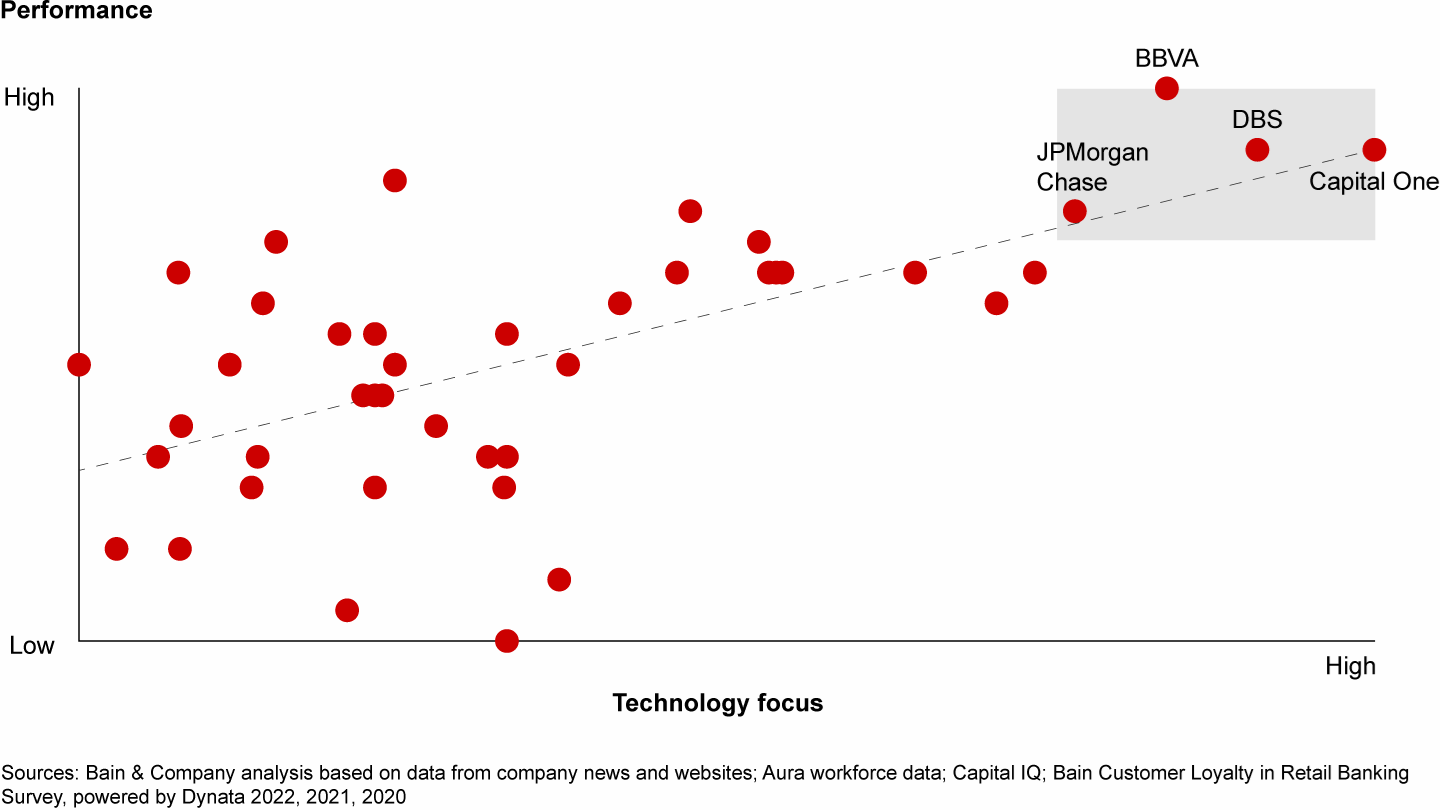Brief

At a Glance
- There is a strong correlation between a bank’s technology choices and its performance, showing that overall success hinges on deft use of technology rather than on simply spending more on technology.
- Bain & Company analysis finds that banks leading in technology deliver an average of 5 percentage points higher total shareholder return, 10 percentage points lower cost-to-income ratio, and 12 points higher Net Promoter Score℠ than their peers.
- Creating value from technology entails sustained simplification, low-cost and adaptable processes, and a great digital experience for customers.
- Three strategies have worked to date. Each requires persistent focus by the C-suite, an excellent engineering function, commitment to transform the business and not just the technology, and consistent investment over time.
As select banks globally are proving, technology has become a new basis for competitive advantage. Whether pursuing platform modernization, a digital experience for customers, advanced data analytics, or new forms of artificial intelligence, leading banks use technology to gain an edge in areas ranging from process efficiency to product innovation. By helping lower costs associated with running the bank, technology frees up the bank’s investment capacity to improve products and the customer experience. This has created a virtuous cycle: lower run costs, higher investment in efficient and delightful technologies, happier customers, and more revenue and profits to invest.
Effectively deploying powerful technology has become critical to banks’ success, for several reasons. Consumers and business customers demand simple, convenient, data-rich, and more tailored digital experiences, and they can easily move their money to whoever has the best offer. Digital-native and major technology vendors still threaten traditional banks. Regulatory compliance requirements continue to expand. And the best technology talent is gravitating to leading banks as great places to work.
Modern technology, like cloud-native banking platforms and AI-supported processes, can enable banks to automate sophisticated tasks and thereby provide real-time responses to customers at a low cost. Banks can tap into an ecosystem of vendors to verify customers’ identities through biometrics. Continuous integration and continuous delivery tools and best practices enable companies to deliver more with less.
However, for all that banks spend on information technology—worldwide, on average, about 16% of their total cost base—many still get mired in complexity with high operating costs due to legacy technology, bloated IT assets, and complex processes. These characteristics combine to limit investment capacity, leading to an inferior customer experience and product portfolio, and resulting in low customer ratings and high defection.
The solution is neither to scale back ambitions and spend less, nor to simply spend more. Instead, it starts with a clear strategic intent from the top to modernize the business and its technology underpinnings to simplify and accelerate growth of the business. It’s all about intentional choices across the business.
What technology leaders do differently
To tease out which choices matter most, Bain & Company analyzed the 42 largest banks worldwide by assets. We assessed their results along three dimensions: total shareholder return (TSR) and cost-to-income ratio (CIR) over the past three years, and Net Promoter Score℠ (NPS) from the first quarter of 2023. We then assessed their technology choices along 11 variables, ranging from board composition to a modern technology stack to the mix of IT staff profiles.
In a regression analysis of the variables, we found that banks with a strong focus on technology rank among the top performers globally and show an average of 5 percentage points higher TSR than other banks in their region, 10 percentage points lower CIR, and 12 points higher NPS.
The strongest correlations of high performance were:
- A tech-savvy board of directors. Technology strategy and performance must be paramount for the board and C-suite.
- A higher number of in-house engineers and fewer other IT staff. Winning banks have built a world-class engineering function for the parts of the business and technology stack that require differentiation.
- Positioning as a technology company. A technology-centered mindset pervades leaders’ operating model, organization, and talent.
In addition, these leaders have a clear view of target architecture. They modernize where it matters most to create a distinctive competitive advantage on customers, economics, and risk.
The differences between tech leaders and other banks were stark (see Figure 1). Notably, spending more on technology alone did not lead to better performance. In fact, IT spending relative to revenue had a negative correlation with performance. Complexity increases when a bank ramps up IT spending too fast, because the funds can go to the wrong places, without the right oversight of architecture or continuous decommissioning.
A handful of technology choices have an outsized effect on performance


BBVA, DBS, Capital One, and JPMorgan Chase stood out as their regions’ performance leaders (see Figure 2). At the start of their journeys, the link between their choice of technology as a core differentiator and their performance outcomes was not well established. But their stories illustrate the powerful consequences of the choices they made.
Top-performing banks have a consistent, strategic focus on technology


Strategic choices toward tech leadership
As we examined these businesses, we found three effective paths, plus an additional emerging path that has yet to play through and may become viable.
Reduce costs through simplification. Some banks will want to focus on simplifying and standardizing products, processes, and technology to increase productivity and efficiency. Reducing operating costs will allow more investment in innovative technologies that change how work is done. This route typically applies where there’s an urgent need to drive down costs and simplify ongoing operations. It requires replacing the legacy technology stack and using modular components in the target architecture.
Santander took this path after it recognized the need for business simplification and defined digital transformation and operational excellence as two of its three top priorities. It attained the major milestone of increasing its number of digital customers from 13.6 million in 2014 to 32 million in 2018. Santander also simplified processes to enable next-day openings of accounts and cards; these openings previously took a week. In 2021, technology again ranked as a high strategic priority, with a $4.7 billion investment. From 2015 through 2022, the bank reduced its cost-to-income ratio by 6.5 percentage points, reaching the first quartile in technology and performance among the banks we analyzed.
Use digital and data to connect with customers. Here, a bank focuses on improving its digital channels and on using data and analytics to improve experiences for customers and employees. Succeeding with this approach requires hiring more staff in customer experience design and in data analytics. A bank should commit to investing in flexible, responsive channels and in the supporting data and data disciplines.
At JPMorgan Chase, a modernization program is restructuring or replacing apps for the cloud and decommissioning 2,200 applications. The bank has been investing heavily in improving data and building a data scientist team of more than 900 people, key elements of a successful AI strategy. Its efforts were recently recognized by the Evident AI Index, which ranked the bank first in AI capabilities among major banks. JPMorgan Chase spent about $14 billion on technology in 2022, with the “change-the-bank” portion of the investment growing 11% over the previous three years. CEO Jamie Dimon has repeatedly defended such heavy spending to skeptical Wall Street analysts, with AI and machine learning leading to an expected business impact of more than $1.5 billion.
Become a technology powerhouse. When a bank commits to becoming a technology company at every level, pervasive, continuous investment can increase both flexibility and innovation. For this model to work, the core technology must already be modern, extensible, and scalable, and the bank must invest heavily across the full technology stack and engineering talent.
Capital One adopted a cloud-first approach in 2020, closing its last data centers and moving core IT as well as customer-facing applications to the cloud. Open-source technology has contributed to more than 100 projects. In 2022, Capital One started developing and selling software products to help its business customers scale up their use of data and the cloud. Its 12,000-strong technology staff is well-respected, frequently attracting talent from major technology firms.
Replace the legacy stack with a clean slate. When the complexity is too great or a bank needs to deliver new products and experiences faster than current technology will allow, some degree of disruption may need to occur. Some banks have decided to launch new banks from scratch, exposing their teams to leading-edge technology and creating a possible path to core banking replacement. Whether these efforts succeed depends on their ability to migrate customers to the new platform and decommission the old one.
One incumbent bank recently started on this route, investing more than €500 million to build a digital bank under a sub-brand. The bank plans to migrate millions of its current customers—especially those who today use the bank’s app rather than branches—and save more per year than the total amount invested. The transformation achieved with the digital bank’s operations is extending to all areas of the banking group, through new investments in a fully digitized customer experience, as well as new solutions based on artificial intelligence in compliance activities. While building the digital bank took only two years, transforming the incumbent’s operations is planned to take place over four years.
Common commitments
The path a bank takes to modernize technology obviously depends on its starting point, strategy, and appetite for change. However, several features characterize each of the four approaches described here:
- Technology is a strategic priority for the board and C-suite, who see it as a core source of competitive advantage.
- Business and IT groups change in lockstep, collaborating to avoid complexity.
- Investing in simplification is a discipline, not a one-time project. There will always be forces working to increase the complexity of architecture, vendor ecosystem, app portfolios, and data assets.
- Building a world-class engineering function and architecture capability is a goal for the parts of the business and technology stack that merit differentiation in the market.
- Technological change and investment are constant and will gradually replace some other types of spending, such as call center staffing and physical branches.
The strong correlation between performance and strategic choices around technology highlights the importance of getting strategy and execution right. Leaders such as BBVA, DBS, Capital One, and JPMorgan Chase demonstrate that creating a winning cycle in technology stems from rigorous, consistent efforts to simplify and modernize where it matters most.